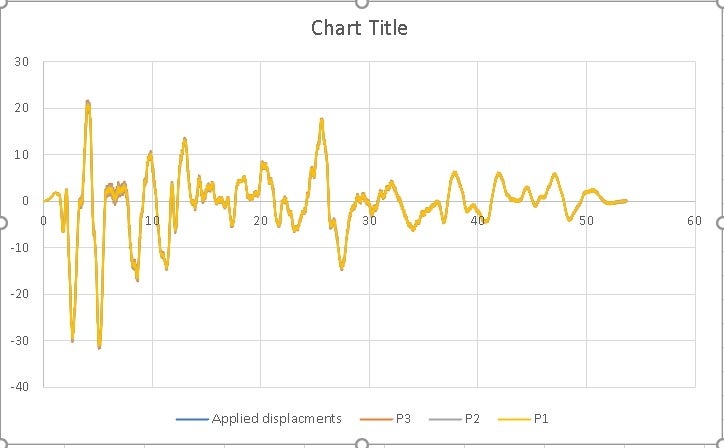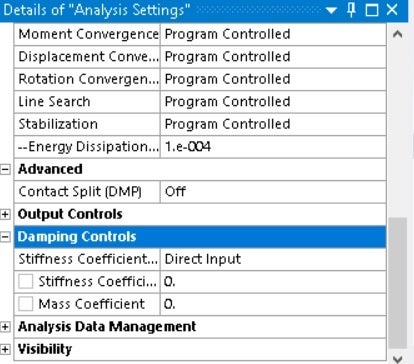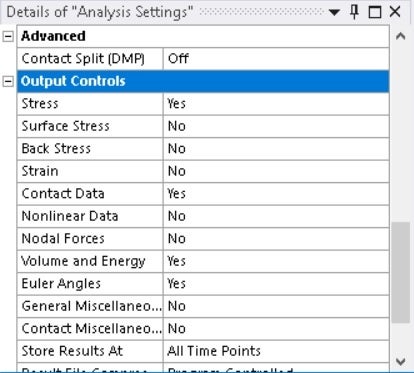TAGGED: concrete, earthquake, time-history, transient-structural
-
-
November 2, 2021 at 8:31 am
Baloch
SubscriberDear All,
I am doing a time-history analysis in transient structure for a RCC structure with a give earthquake acceleration. I used the approach of fixing the based of the structure and applying acceleration to all bodies. I need to validate the simulation against an experiment work. While every thing seems correct still I am getting much lower results compared to the experimental work given in the paper also attached. The model file is also attached.
November 10, 2021 at 9:38 pmSheldon Imaoka
Ansys Employee
Unfortunately, I cannot download your attachments, but based on what you noted, you probably want to use a Base Excitation instead (Acceleration object with "Base Excitation: Yes") applied at your base, not an inertial load applied to the entire structure. Note that this will require use a mode-superposition transient analysis.
What results are 'lower' than expected? Is it deformation or stresses? (Sorry, but as noted above, I cannot download your attachments.) Note that you will need small timesteps for a seismic analysis - the timesteps must be small enough to capture the dynamic response (e.g., 1/20 of period of highest frequency).
Regards Sheldon
November 11, 2021 at 1:58 amBaloch
SubscriberDear Doing a mode-supervision will not consider non-linearity which are crucial in my case. yes for the deformations they are extremely small since I need to have around 13mm what I have around below 1mm which is even not logical. And for time step since the earthquake has a predefined time series can we change it?
November 11, 2021 at 2:29 pmSheldon Imaoka
Ansys Employee
In that case, you can run a nonlinear transient analysis with the full method. The timestep size is selected by you, the user - ensure that it is small enough to capture not only the excitation but dynamic response. If you are off by an order of magnitude, you may also wish to double-check your inputs (e.g., damping values, boundary conditions).
Regards Sheldon
November 11, 2021 at 2:43 pmBaloch
SubscriberThank you While using the full transient analysis I am not able to select acceleration as base excitation. To make it sure fixing the base of the structure and applying acceleration to all bodies is a correct Approch?
Best regards
November 11, 2021 at 2:54 pmSheldon Imaoka
Ansys Employee
If you use that approach, keep in mind that you are calculating displacements relative to the base. In your model, it seems that the base is not moving (since it is fixed), so the displacements you calculate will be less if measured from a stationary reference. Check what you are comparing your results against - if the values are non-zero at the base, then your values will always be much lower since you are only calculating the difference in displacements with your base. The simple solution is to either determine the relative deformations from your reference source or to add the base profile to your results.
(The alternative is to convert your acceleration profile to a displacement profile by integrating with respect to time before solving and applying the displacement time-history profile on your base.)
Regards Sheldon
November 11, 2021 at 7:23 pmBaloch
Subscriber Dear
For first approach displacement at the base are Zero since my face is fixed. I am trying to figure it out but results looks strange since on each floor displacements are same over time do you have idea why is it?
Dear
For first approach displacement at the base are Zero since my face is fixed. I am trying to figure it out but results looks strange since on each floor displacements are same over time do you have idea why is it?
For later approach when looking at the results the deformations are almost same as the applied base displacements as shown in figure.
Do you have Idea what might be wrong?
Best regards
November 11, 2021 at 7:37 pmSheldon Imaoka
Ansys Employee
If you are plotting multiple points on your structure and they all look the same, that means that the structure seems to be moving rigidly together. Try solving a modal analysis to see if your frequencies of your structure are realistic.
Just to confirm, but you are running a transient structural simulation with density (and damping) defined, right? Did you turn off time integration in "Analysis Settings" (it should be left as default "On" - otherwise, it will be a static analysis)?
Regards Sheldon
November 11, 2021 at 7:58 pmBaloch
SubscriberDear Yes it seems like the structure is moving rigidly.
1)I defined the density as usualy from material properties however I am using microplane model for concrete, I am now afraid the microplane model command is overwritting all properties or just the defined ones can you have a look to it?
2)For damping I didnt changes any thing kept the settings as usual.
3) For advance setting the default is moderate speed dynamics, does this matter and what should be used for seismic


 loading?
loading?
November 11, 2021 at 8:03 pmSheldon Imaoka
Ansys Employee
I cannot download any attachments, but please check that your materials are defined in the same unit system as you are solving.
Try solving without the "Commands (APDL)" object first, using the same elastic properties. That will give you an idea if the "Commands (APDL)" object is the source of the problem.
Regards Sheldon
November 11, 2021 at 8:10 pmBaloch
SubscriberDear Thanks for the recommendations , I will try those.
Best regards
November 18, 2021 at 10:08 pmBaloch
Subscriber
I Run a model analysis and the frequency of the structure looks realistic. I tried to many techniques but nothing works apart from undesirable results all the ways I am facing rigid body motion. Let me complete describe my modelling steps.
1) I created the all concrete as a solid body and reinforcements as line bodies.
2) Used solid185 elements for concrete and link180 for reinforcement with behavior as hard because I am using CINTF command to bond reinforcement and concrete.
3) For analysis setting I turned off the auto time stepping since my loading is earthquake time history and time integration us ON as default.
4) My structure is fixed at the base so i fixed all the six columns bottom face.
5) Applied standard earth gravity load as well.
I used the approach of fixing the base and applied acceleration to all bodies and also used the approach of applying displacement at the base by applying displacement time history on desire direction while making the other directions as constant (0). But with both the approaches I am getting rigid body motion. Also used non linear and elastic materials for both having almost same results. (For full transient).
I also performed time history analysis by Model superposition by following scheme (Static-model-transient), (transient-model-transient) but the rigid body motion is still there.
Could you please help me what might be the problem with my analysis? Or can you recommend me any material? Since I searched a lot but could not find a single tutorial which is performing time history analysis by full transient specially for seismic loading.

Best regrads
December 1, 2021 at 5:44 pmSheldon Imaoka
Ansys Employee
You mentioned that you are getting "rigid body motion", but I just wanted to check if that is the case since your original description of the problem did not specify rigid-body motion. If your deformation is small, such that the top floor has the same displacement as the applied displacement, that is not 'rigid-body motion'. Rigid-body motion means that the entire structure is translating without any constraints. I am just checking if I understand the situation correctly since "rigid body motion" is the opposite of the problem you described earlier. (A body that acts rigid (no relative deformation between top and bottom floors) is not 'rigid-body motion'.)
I'm not sure how long your simulation takes to run, but can you try suppressing the rebars and any "Commands (APDL)" objects you may have? Just perform a transient analysis of the concrete structure with linear elastic material properties to see if you do not get the expected deformations. If you do get expected deformations with "Commands (APDL)" objects and non-concrete materials suppressed, then unsuppress some features at a time to isolate what the problem may be. If you do not get expected deformations with just concrete and linear elastic materials, then there is something fundamentally incorrect about the setup.
By the way, in the chart of displacements you showed earlier, is the x-axis milliseconds or seconds? I see it go past a value of "50", but it wasn't clear to me the time scale.
Regards Sheldon
December 2, 2021 at 2:32 pmBaloch
SubscriberThank you for the response By rigid body motion I meant the deformations on all floors are almost same.
Yes those are the deformations along x-axis which are my interest since my loading is along X-axis. The time is in seconds, total timing of my earthquake is around 53.71sec.
However, For this stage I found my problem , some how I manage to bring the structural first natural frequency equal to that given in experimental work. Now my structure is behaving as expected.
Thanks again for your time.
Viewing 13 reply threads- The topic ‘Any one can help what mistake I am doing for time history analysis of a RCC structure?’ is closed to new replies.
Ansys Innovation SpaceTrending discussionsTop Contributors-
3597
-
1283
-
1117
-
1068
-
983
Top Rated Tags© 2025 Copyright ANSYS, Inc. All rights reserved.
Ansys does not support the usage of unauthorized Ansys software. Please visit www.ansys.com to obtain an official distribution.
-
The Ansys Learning Forum is a public forum. You are prohibited from providing (i) information that is confidential to You, your employer, or any third party, (ii) Personal Data or individually identifiable health information, (iii) any information that is U.S. Government Classified, Controlled Unclassified Information, International Traffic in Arms Regulators (ITAR) or Export Administration Regulators (EAR) controlled or otherwise have been determined by the United States Government or by a foreign government to require protection against unauthorized disclosure for reasons of national security, or (iv) topics or information restricted by the People's Republic of China data protection and privacy laws.











